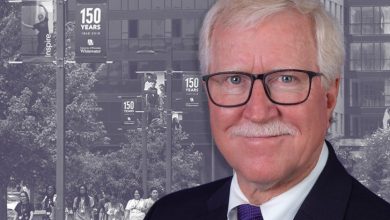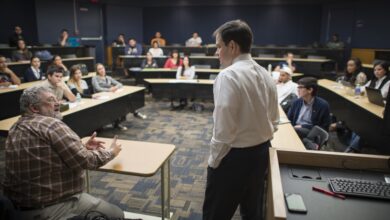One of America’s Oldest Hospitals Lay Abandoned. Then a University Stepped In.

[ad_1]
The last time Lee Hamm was working in New Orleans’s Charity Hospital, critically ill patients were being hauled up and down dark, sweltering stairways as nurses hand-pumped oxygen to keep them alive. In August 2005, for those inside a hospital ravaged by Hurricane Katrina, the sounds of helicopters whirring nearby only added to the frustration, as day after day went by with no rescue.
Over the next 18 years, Hamm,now a senior vice president and dean of medicine at Tulane, relived memories both horrifying and inspiring as he looked out the window of his nearby office building. There, in a gritty portion of New Orleans’s downtown, the abandoned skeleton of Charity Hospital loomed, boarded up behind chain-link fences and overgrown weeds. The million-square-foot Art Deco building occupied a full city block.
To many, the state’s decision in 2005 to shutter Charity represented the neglect of New Orleans’s most vulnerable residents. The iconic hospital had served as a safety net since the 1700s, doing so in its current structure since 1939. “This building that was brought to its knees during Katrina and not built back,” said Tulane University’s president, Michael A. Fitts. “That symbolized a lot to the community.”
So too, he hopes, will Tulane’s decision to help bring Charity back. The university is spending $135 million on the hospital building, where it plans to move its School of Public Health and Tropical Medicine by the end of 2026. Approximately 600 researchers and research staff from the medical and public-health schools will also move into the overhauled building. Tulane will serve as an “anchor tenant,” taking up about a third of the former hospital. Hamm will oversee the creation of new labs and research space for Tulane’s medical school.
The mixed-use building will also house apartments and retail space, as well as the Tulane Innovation Institute, a center designed to turn university-funded research into products faster. Beyond its investment in Charity, Tulane will spend another $465 million expanding its presence in the surrounding downtown biomedical corridor, with the hope of revitalizing the area as a hub of bioscience research.
At a time of public questioning about the contributions colleges make to their communities, Tulane’s latest investment demonstrates how deeply the fates of higher-education institutions and the cities they inhabit are intertwined. When urban campuses swallow city blocks and residents are displaced, the projects often breed resentment. Tulane’s plans, though, have been welcomed because the hospital and its immediate surroundings have been abandoned in a section of downtown that’s become an eyesore and a constant reminder of Katrina.
Expanding in a downtown biosciences corridor makes sense, strategically and financially, for the private university of more than 14,000 students, Tulane officials say. The university’s enrollment has been inching up, and construction continues at its pristine uptown campus. But given the growth in its health-related graduate programs and the desire to be closer to the city’s economic center, expanding downtown is a priority, they say.
Meanwhile, Charity Hospital is “an iconic building with so many stories and histories,” Fitts said, a place where thousands of lives were saved and generations of health-care workers trained. The building that stood empty for nearly two decades “symbolized in many respects the tragedy of Katrina.” Although Charity will no longer be involved in the kind of direct patient care it provided before Katrina, the education and research that will take place there send an important signal, Fitts said, about the university’s commitment to the community’s well-being and health.
This building that was brought to its knees during Katrina and not built back. That symbolized a lot to the community.
By supporting and encouraging the development of biomedical start-ups, Tulane hopes to help diversify the economy of a city that has historically relied on hospitality and tourism, both of which took huge hits following Hurricane Katrina and the Covid-19 pandemic.
The president cited a number of cities that were transformed because of their relationships with prominent universities. “You look around the country, and it’s amazing how much development has occurred in cities as a result of universities — obviously Silicon Valley and Cambridge — but also Nashville, Austin, and Pittsburgh,” Fitts said. “We’re in the middle of an idea revolution as well as a biomedical revolution. I just think this is the perfect moment for Tulane to make a commitment substantively, geographically, and symbolically to the downtown.”
Another plus, according to Mike Strecker, a Tulane spokesman, is that external funding for Tulane research has risen by close to 50 percent over the past four years, and the university expects it to increase another 50 percent over the next few years.
The overhauled Charity Hospital building will include about 20,000 square feet of space for students to study and socialize. The developers plan to retain the building’s Art Deco facade, as well as the lobby and other historical features.
Plans for the innovation district include affordable-housing units and jobs for neighborhood residents. That’s especially important in a place where rapid gentrification has made living in the city unaffordable for long-time residents, many of them families of color, said Marla K. Nelson, a professor of planning and urban studies at the University of New Orleans. Urban-renewal projects and tourism influxes were largely blamed for pushing families out of the historic Tremé neighborhood, near the French Quarter, one of the nation’s oldest Black neighborhoods and to many, the birthplace of jazz.
Fitts said that’s not going to happen in the area around Charity Hospital, which is blighted and largely abandoned. “We’re taking over vacant buildings and parking lots,” he said. “We’re not displacing anybody at all.”
‘Where the Unusual Occurs’
Charity Hospital was founded in 1736 as a New Orleans hospital for the poor, funded by a dying French ship builder. It became the second oldest continually operating public hospital in the country. The 1939 building, whose architects also designed the Louisiana State Capitol, in Baton Rouge, replaced earlier ones that burned or were too small for the growing number of indigent people needing care. It served the city’s poor until the severe damage caused by Hurricane Katrina forced it out of service.
Until Katrina struck, “Big Charity,” as it was known, was one of two New Orleans teaching hospitals affiliated with Louisiana State University. The other, located nearby, was University Hospital. Instead of reopening Charity Hospital after Katrina, the state approved LSU’s proposal to replace the two hospitals with a new, $1.1-billion University Medical Center. That move, made possible by a hefty disaster-relief payment from FEMA, left bitter feelings among those lobbying for Charity to reopen, as recounted in an award-winning documentary about the hospital’s closure.
Over the years, the 20-story building became a fixture on the city’s ghost tours and the subject of rumors of paranormal activity. (Part of the recently released movie Renfield, a modern-day adaptation of Dracula, was shot on site after the production designer noted that the building “looks like the classic silhouette of a vampire castle.”)
In 2005, I was among a group of Chronicle reporters who traveled to New Orleans and Baton Rouge, where many New Orleans residents had been evacuated, in the days immediately following Katrina. Having heard harrowing stories about the conditions inside Charity and the city’s other public hospitals, I was eager this year to see for myself what was behind the broken and boarded-up windows and locked gates that had shielded the inside from view for the past 18 years.
A tour in February with Hamm, the Tulane med-school dean, started on the first floor, where the emergency room stood before the rising floodwaters forced the staff to relocate it upstairs. The hospital’s motto is written in large letters on the wall, still visible beneath the grime: “Welcome to the Medical Center of Louisiana. Where the Unusual Occurs and Miracles Happen.” In another room, a ceiling-mounted surgical light is poised over an operating table, seemingly frozen in time.
The hospital held up surprisingly well during the initial phase of the storm, which slammed into the Gulf Coast on Monday, August 29, 2005, lashing New Orleans with heavy rain and high winds, the dean said. By late that day, the streets were dry, the air calm, and it appeared the city had dodged a bullet. But by that night, water from distant, breeched levies began trickling down the street and on Tuesday, was flooding into the hospital buildings, he said. The next several days, as the water rose to waist height in the streets around the hospital, were a nightmare inside Big Charity. The generators that had kicked in were in the basement and soon submerged. With no water or electricity, temperatures swelled well above 100 degrees.
Hamm and two other doctors paddled over to Charity, one block away from his office, in a canoe a colleague had brought in from home to check on evacuation efforts. Without electricity, emergency workers were using manual ventilation bags to breathe for patients who would normally be hooked up to machines. Residents were hauling patients on flat stretchers that weren’t designed to make the tight turns in the dark stairways. Bodies from a flooded morgue were stacked in a stairwell.
More than 1,500 patients, staff, and refugees from the community were trapped inside Charity Hospital for days without food and drinkable water. While people were being plucked off of rooftops in submerged sections of the city, and evacuations were underway at the private Tulane University Hospital, no one seemed aware that thousands were trapped inside the city’s public hospitals. When word did get out, Hamm said, “They were told help was coming, and it didn’t come.”
Some patients were paddled by boat across flooded streets and carried up to a rooftop parking deck, where a few died awaiting rescue that finally came, nearly a week after the hurricane struck. Like others who stayed behind to help with the rescue efforts, Hamm was one of the last people evacuated out.
Like any financially constrained safety-net hospital where medical trainees are treating unpredictable influxes of poor and mentally ill patients, Charity faced its challenges long before Katrina struck its near fatal blow.
“A lot of good things happened in that building,” Hamm said. “I’m sure there were things that weren’t as good as they should have been, but the hospital has taken on the symbolism of compassionate care to those that need it most. To be back in that building will be terrific.”
[ad_2]
Source link






